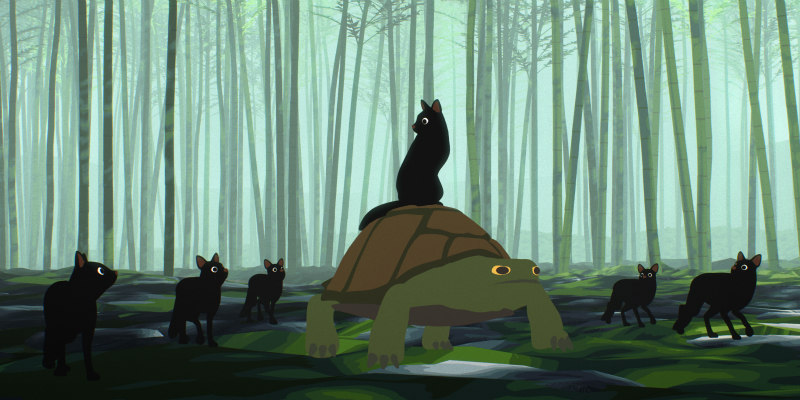
Review by Benjamin Poole
Directed by: Gints Zilbalodis

I think it was last month that MUBI had the peerless
Popeye the Sailor Meets Sindbad the Sailor on, and watching
the grumpy little seafarer battle Bluto and various proto-kaiju again (and
again) it was so cheering to see how modern it all still feels, how fresh
and witty. Reviewing Fleischer’s mini masterpiece of almost a century ago
reassures you of animation’s pure cinema, its status as a visual medium
hermetically engendered by developing industry and the imagination’s
sempiternity. Animation is cinematic spectacle distilled: a parade of
illusory movement, which pushes the limits of the available technology while
providing a platform for the concepts and ideas that live action could never
approach. The medium, however, becomes deeply boring when fealty to the
former component overwhelms the latter, when eye-popping style is empty of
emotion or convincing narrative drive.
Alita: Battle Angel
may have raised some bars and eyebrows, but it won’t be returned to in the
way that Into the Spider-Verse will, a film that managed its
ratio of visual dynamism and emotion to astounding effect. And yet these
sorts of triumphs may prove prohibitive to the discipline, in the sense that
competitive spectacle sets lofty expectations which lower budgeted
productions cannot match.

Take Gints Zilbalodis’ Away, a transcendent animation from Latvia, for its beauty, its humanity and its urgent narrative energy, but leave alone the derisory user comments offered on imdb by some very, very, very silly little shits bemoaning the crudity of the art and the perceived shabbiness of Away’s realisation. Yes, Away may have the visual mien of a cut scene in a mid-budget video game, and the chintzy colour palette of Paint, but for what it lacks in available budget (the film was arts council funded), it compensates with cinematic imagination, thrilling storytelling and an eye for imagery which is utterly breath-taking.
[ READ MORE: New Release Review - The Exception ]
Nothing is wasted in Away (imagine drawing months’ worth of sequences for them not to work! Animation has no room for Kubrickian faffing about), and its tight as a drum narrative begins with a boy in a tree, dangling by the drawstrings of his recently deployed parachute, a burning plane drifting in the far distance above. The kid is not completely alone though... Like the looming hulks of a Stålenhag painting, there approaches a monster humanoid in shape, but sinisterly adumbral in manner, and which has the boy in its deadly sights. The creature puts you in mind of Tove Jansson’s the Groke - a similarly Jungian monster which inspires existential dread in all those unfortunate to witness her. Like the horror which haunts Zilbalodis’ horizons, the Groke freezes to death the ground she passes upon and is so "terribly evil she would wait for ever." The kid must have read the same books I grew up on, because he’s not hanging around anymore. Homeboy runs and the slow chase narrative of Away begins...

With an ambient soundtrack reminiscent of the last Nine Inch Nails album, and occasionally, even mid-career Aphex (art, direction, editing: Zilbalodis does it all, including the score. Perhaps he is a genius), the boy is chased through differing vistas (which, I think, represent the seasons) by the lumbering death beast. Yes, a bit like fragile life itself: this is bare bones narrative hewn from our most basic of instincts. In congruity with the very function of the animated medium (adj ‘made or equipped to move’), both the child and the film must keep in perpetual motion. Stasis equals death in Away: for the poor foal who falls asleep in the path of the zombie-like shamble of the shadow, and potentially for the baby bird who isn’t quite strong enough to match the mass flight of his flock southwards (a key indicator of Away’s insistent transcendentalism).
[ READ MORE: Blu-Ray Review - The Don is Dead ]
The personality and character which Zilbalodis generates from what is essentially a fluttering, angular blob as it becomes the kid’s companion is an unfettered joy, and gives way to a knife-edge sequence involving the boy attempting to sabotage the encroaching ghoul with a dropped boulder and a decrepit bridge (a droll nod to Away’s Roadrunner forerunners) while a wolf, sensing the distraction, stalks the chick - yikes! You will scream at the screen in a full-on anxiety attack.

The style of the film expresses the urgency of the dramatic situation. When the boy is temporarily safe, the landscape flows via running water and branches bayed by the breeze. The monster, however, is associated with geometric, static formations: tunnels which bisect the landscape and immutably sharp rocks creating fatal obstructions. Like death, which is the ultimate ceasure of motion, the monster is always there, waiting, in no rush, because it knows that one day it will prevail - all the kid can do is keep as far away from it as he can, for as long as he can. Away’s budget may well be low, but its perspective is unflinching and its heart is true. What a film.

Away is on UK Digital/VOD now.
